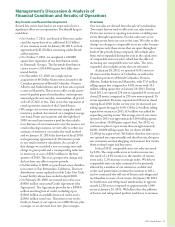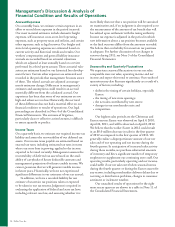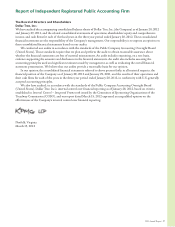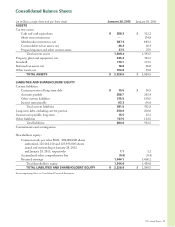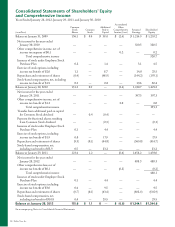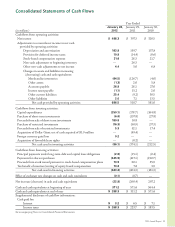Dollar Tree 2011 Annual Report Download - page 27
Download and view the complete annual report
Please find page 27 of the 2011 Dollar Tree annual report below. You can navigate through the pages in the report by either clicking on the pages listed below, or by using the keyword search tool below to find specific information within the annual report.
0DQDJHPHQW·V'LVFXVVLRQ$QDO\VLVRI
)LQDQFLDO&RQGLWLRQDQG5HVXOWVRI2SHUDWLRQV
Inflation and Other Economic Factors
Our ability to provide quality merchandise at a fixed
price and on a profitable basis may be subject to
economic factors and influences that we cannot control.
Consumer spending could decline because of economic
pressures, including unemployment and rising fuel
prices. Reductions in consumer confidence and spending
could have an adverse effect on our sales. National or
international events, including war or terrorism, could
lead to disruptions in economies in the United States
or in foreign countries. ese and other factors could
increase our merchandise costs, fuel costs and other costs
that are critical to our operations, such as shipping and
wage rates.
Shipping Costs. Currently, trans-Pacific shipping rates
are negotiated with individual freight lines and are
subject to fluctuation based on supply and demand for
containers and current fuel costs. We can give no assur-
ances as to the final rate trends for 2012, as we are in the
early stages of our negotiations.
Minimum Wage. In 2007, legislation was enacted that
increased the Federal Minimum Wage from $5.15 an
hour to $7.25 an hour over a two year period with the
final increase being enacted in July 2009. As a result,
our wages increased in 2009 and through the first half
of 2010 compared with the prior year periods; however,
we offset the increase in payroll costs through increased
productivity and continued efficiencies in product flow to
our stores.
QUANTITATIVE AND QUALITATIVE DISCLOSURES
ABOUT MARKET RISK
We are exposed to various types of market risk in the
normal course of our business, including the impact of
interest rate changes and diesel fuel cost changes. We may
enter into interest rate or diesel fuel swaps to manage
exposure to interest rate and diesel fuel price changes. We
do not enter into derivative instruments for any purpose
other than cash flow hedging and we do not hold deriva-
tive instruments for trading purposes.
Interest Rate Risk
We use variable-rate debt to finance certain of our opera-
tions and capital improvements. ese obligations expose
us to variability in interest payments due to changes in
interest rates. If interest rates increase, interest expense
increases. Conversely, if interest rates decrease, interest
expense also decreases. We believe it is beneficial to limit
the variability of our interest payments.
To meet this objective, we entered into derivative
instruments in the form of interest rate swaps to manage
fluctuations in cash flows resulting from changes in the
variable-interest rates on a portion of our $250.0 million
term loan. e interest rate swaps reduced the interest
rate exposure on these variable-rate obligations. Under
the interest rate swaps, we paid the bank at a fixed-rate
and received variable-interest at a rate approximating
the variable-rate on the obligation, thereby creating
the economic equivalent of a fixed-rate obligation. We
entered into two $75.0 million interest rate swap agree-
ments in March 2008 to manage the risk associated with
the interest rate fluctuations on a portion of our $250.0
million variable rate term loan. ese swaps expired in
March 2011.
2011 Annual Report 25


